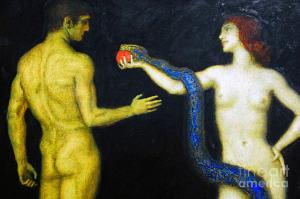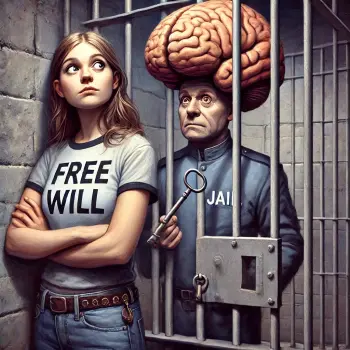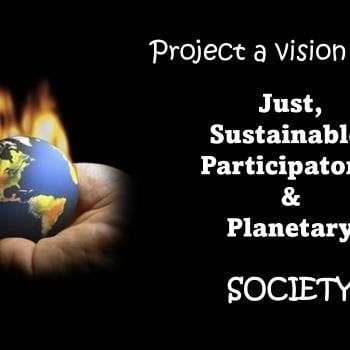 Just as our lungs are programmed to inhale oxygen at all cost, you and I inhale the good at all cost. If our bronchioles absorb polluted air, we cough. If our conscience absorbs sin, we cough and then tell a lie. We cough, lie, and sin only in the name of the good.
Just as our lungs are programmed to inhale oxygen at all cost, you and I inhale the good at all cost. If our bronchioles absorb polluted air, we cough. If our conscience absorbs sin, we cough and then tell a lie. We cough, lie, and sin only in the name of the good.
Oh no! Not more on sin! Yes, it’s sin again. Please bear with me. (Painting by Heteronomous Bosch)
As you undoubtedly know, sin is not popular. Daniel Fincke says “sin is a morally bankrupt and and biologically backward concept.” In contrast to Fincke, I believe the concept of sin is one of the brightest lights the public theologian can shine into the darkness of racism, jingoism, family abuse, and our daily fare of maligning rhetoric.
Even so, sin-talk can itself be toxic. “Memories of church from my youth summon up feelings of fear and shame,” complains Philip Yancey. “It was hard to hear the gospel as good news when most sermons centered on sin and hell.” Even if the topic of sin is unpopular, I find that we simply cannot understand human nature without the concept of sin.
Sin may be unpopular. But evil is popular. Evil even garners it’s own television series. Evil also garners a theological interpretation by Kate O”Hare. What such TV treatments typically do is confuse the split between the natural and the supernatural with the split between good and evil. When we ascribe evil to the supernatural, we feel a tad safer watching from the natural side of the TV screen. Even so, you and I find ourselves intrigued by evil, as long as we find ourselves safely on the good side of the line we draw.
In another Patheos column, Roger Olson argues that the objectivity of evil is evidence of God. “This is the strongest evidence for God–that everyone believes in evil and at least acts like evil is at least more than what ‘I find abhorrent’.” Yes, there is an objectiveness about evil that is more than merely my opinion. It is the case that everyone knows evil when they see it. But, just who is evil? Not me! Somebody else is evil. And I am good when I point out this evil for everyone else to see. The irony, of course, is that this very pointing out of evil is inextricably connected to our sinning.
What!? That does not make sense! How can my pursuit of the good over against evil be connected to sinning?
Is Sin Simple or Subtle?
“Western Christians have for a long time defined ‘sin’ as breaking God’s law,” observes Jackson Wu. Is that adequate? Not by a long shot. Recall that the serpent in the Garden of Eden was described as “subtle” (Genesis 3:1). Here we will look at the subtle side of sin. Sin begins with your and my uncompromising desire to be good, to be right.
Our desire for the good makes our sinning enigmatic. A puzzle. Senseless. “Sin makes no sense…Sin, therefore, is radically unintelligible,” observes Anglican theologian Cynthia Crysdale (Crysdale, 2019, p. 473). Here we are trying to make sense out of something that otherwise makes no sense. Let’s start with what we do virtually every day, namely, justify our sin by making ourselves look good. Without even recognizing it, we daily engage in mental rituals of self-purification by scapegoating those we deem more evil than we are. Really? Yep. Really.
In an earlier Patheos column I claimed that sin is real even if evil does not exist. Evil is the active power of non-existence, of nonbeing, of destruction. Evil destroys truth with the power of the lie. What is the nature of that lie? Answer: Self-justification. We will develop this insight in a series of five treatments of sin. (1) Sin 1: Sin? Really? (2) Sin 2: Self-Justification. (3) Sin 3: the Visible Scapegoat. (4) Sin 4: the Invisible Scapegoat. (5) Sin 5: Sin Boldly! One task of the public theologian is to clarify discourse, so to speak, to make visible the partially hidden structure of self-justification and scapegoating that takes place in both psyche and society.
Drawing a Line between Good and Evil
Here is what you and I do almost every day in our imagination. In our private mind or in our political rhetoric, we draw a line between good and evil. Then, we place ourselves on the good side of the line. Once we find ourselves on the good side of the line, we breathe easily.

What’s wrong with that? This demonstrates that the human being is basically good, right? Because I am good, other people should like me. Right? (Painting of Adam, Eve, and the serpent by Franz van Stuck.)
Yes, we humans are born with a thirst for what is good. Thank God. But, it’s more complicated. Sometimes we put somebody else on the evil side of that imaginary line. This in turn justifies you and me in behaving badly toward the person on the evil side of the line. We think we have gained the right to punish. We think it is our task to rid the world of the scourge of evil on the other side of our line. No matter how cruel or violently we behave, whatever evil we perpetrate is justified in our own mind. We feel innocent, powerful, victorious.
We perpetrate evil only in the name of the good. What is Good? The right way to do things? God’s will? The security of our nation? Those things are good. Right?
Here is what we do routinely: we draw the line and place ourselves on the good side. On the evil side we place sinners, evil-doers, along with the devil and all his minions. The next day we we draw the line, place ourselves on the good side, and then on the evil side we place our boss because he is allied with sinners, evil-doers, and the devil. The following day we draw the line and place ourselves on the good side. But, on the evil side, we place those who believe in sin and are afraid of sin. “Evangelicals are so enamored with thinking about sin…it has become an endless feedback loop…a never ending cycle of sin, fixation, sin, fixation.” On the fourth day we draw the line and place ourselves on the good side. Who is on the evil side? Take your pick. The evil ones are a moving target.
The problem, of course, is that this is a lie we tell ourselves. It matters zilch whether our accusations against those on the evil side of the line are objectively true or not. The lie is that somehow we ourselves become good by accusing others of being evil.
It is the lie of self-justification. The victim of our self-justification is called the “scapegoat.” We even scapegoat God. That’s right. The sinner scapegoat’s God.
How does this work? To illustrate, let’s turn to the story of Adam and Even in the Garden of Eden, to the paradigm of sin as self-justification.
Adam, Eve, and the Garden of Eden
Let’s go back to the second and third chapters of Genesis. Eve, recall, is looking at the tree bearing the forbidden fruit. She likes what she sees. It appears “good” to eat. At that moment a serpent engages her in conversation. The serpent–the “subtle” or “crafty” serpent–tells her not to hesitate eating the forbidden fruit, because something good will happen. “You will not die,” says the serpent in Genesis 3:4-5: “for God knows that when you eat of it your eyes will be opened, and you will be like God, knowing good and evil.” To have one’s eyes opened, to gain enlightenment, to gain knowledge: now, that sounds attractive! It sounds like the goal of a spiritual quest. (Painting by Hugo van der Goes)
To be like God! Awesome! Deification through apple eating. Awesome!
Being godly is a good thing, right? How could one turn down such an opportunity? Genesis 3:6-7: “So when the woman saw that the tree was good for food, and that it was a delight to the eyes, and that the tree was to be desired to make one wise, she took of its fruit and ate; and she also gave some to her husband, who was with her, and he ate.” Eating the forbidden fruit was a good thing to do. At least, it appeared to be a good thing to Eve.
 There is gain here for both the man and the woman: the knowledge of good and evil. Their eyes were opened. But, this gain included some collateral damage. Suddenly, they realized something they had not noticed prior, namely, they were not wearing any clothes. The biblical text continues. Genesis 3: 7-13: “Then the eyes of both were opened, and they knew that they were naked; and they sewed fig leaves together and made loincloths for themselves. (Painting by Kevin Wak Williams)
There is gain here for both the man and the woman: the knowledge of good and evil. Their eyes were opened. But, this gain included some collateral damage. Suddenly, they realized something they had not noticed prior, namely, they were not wearing any clothes. The biblical text continues. Genesis 3: 7-13: “Then the eyes of both were opened, and they knew that they were naked; and they sewed fig leaves together and made loincloths for themselves. (Painting by Kevin Wak Williams)
Adam and Eve then heard the sound of the LORD God walking in the garden at the time of the evening breeze, and the man and his wife hid themselves from the presence of the LORD God among the trees of the garden. But the LORD God called to the man, and said to him, ‘Where are you?’ He said, ‘I heard the sound of you in the garden, and I was afraid, because I was naked; and I hid myself.’ He said, ‘Who told you that you were naked? Have you eaten from the tree of which I commanded you not to eat?’ The man said, ‘The woman whom you gave to be with me, she gave me fruit from the tree, and I ate.’ Then the LORD God said to the woman, ‘What is this that you have done?’ The woman said, ‘The serpent tricked me, and I ate’.”
Don’t Blame Me! Blame…
We are getting closer to our point. “Nakedness is the key to understanding the story,” claims Morgan Guyton. Almost, but no cigar. The key is found in what comes right after the discovery of nakedness.
Note the chain of self-justification at work here. Adam says the equivalent of “it’s not my fault. Blame the woman you gave me.” Eve follows, “it’s not my fault. Blame the serpent who beguiled me. And, God, while we’re at it, who made the serpent?” Well, God, of course. God is guilty for creating a serpent who talks and lives in the Garden of Eden. It’s God’s fault for denying the man and woman the awareness of good and evil, therefore, God is really the guilty party. Adam and Eve have drawn a line between good and evil, and they’ve put each other, the serpent, and even God on the evil side. We sheepish sinners are desperate to think of ourselves as good. (Painting by Marc Chagall)
“Adam wanted to appear innocent, he passed on his guilt from himself to God, who had given him his wife. Eve also tries to excuse herself and accuses the serpent, which was also a creature of God,” comments Martin Luther. “Here Adam is presented as a typical instance of all sinners and of such despair because of their sin. They cannot do otherwise than accuse God and excuse themselves” (Luther, 1955-1986, pp. 1: 178-179). Adam and Eve drew a line between good and evil; and they placed God on the evil side of that line. In order to justify themselves, they scapegoated God.
Much to the surprise and chagrin of the human race, God voluntarily accepts being placed on the evil side of our line. When you and I self-justify by placing ourselves on the good side of the line, we have separated ourselves from God. But, when we join God on the evil side, then as forgiven sinners we sin boldly! (Peters, Sin Boldly!, 2015) “For our sake he made him to be sin who knew no sin, so that in him we might become the righteousness of God” (2 Corinthians 5:21). But, alas, that’s another story.
Back to our story. Without being daily aware of it, you and I work with the assumption that goodness is eternal. We are so desperate to identify ourselves with what is good that we will vilify our boss, immigrants, Republicans, Democrats, neighbors, and even God if necessary. When we scapegoat God, we in effect judge God by a criterion that transcends God.
Now, on the surface this seems like nonsense. Yet, our intuitions sometimes invest us in nonsense or, more precisely, the lie. It is a lie to declare ourselves good and everyone else, God included, as evil.
Defending Adam and Eve
Actually, one could try to defend Adam and Eve. They did not exactly lie, at least in the full sense of telling a false story. They simply emphasized certain points and perspectives belonging to the true story. Still, it was an attempt to deceive, was it not? They deceived themselves into believing they were good or right or just. But, God was not fooled.
Why might we want to defend Adam and Eve? Might our motive arise from our own temptation to downplay deceit? Are we comfortable with our deceit? Perhaps it would be best to clean the deck and simply say it outright: it’s a lie. “The lie is the specific evil which man has introduced into nature,” says Jewish theologian Martin Buber (Buber, 1953, p. 7).
The father of lies is Satan, says Jesus. John 8:44: “When he [the devil] lies, he speaks according to his own nature, for he is a liar and the father of lies.” Now, who is it: Satan or humanity which introduced the lie into nature? Perhaps it doesn’t matter who told the first lie. We now swim in a churning sea of lies. (Painting by Marlina Vera)
Keep in mind that the lie is only a means to an end. The end is self-purification through self-justification.
Jesus on Self-Justification
Jesus was critical of self-justification. Here is his parable of the Pharisee and the tax collector (Luke 18:9-14). Note the role played by confession here.

[Jesus] also told this parable to some who trusted in themselves that they were righteous and regarded others with contempt: ‘Two men went up to the temple to pray, one a Pharisee and the other a tax-collector. The Pharisee, standing by himself, was praying thus, “God, I thank you that I am not like other people: thieves, rogues, adulterers, or even like this tax-collector. I fast twice a week; I give a tenth of all my income.” But the tax-collector, standing far off, would not even look up to heaven, but was beating his breast and saying, “God, be merciful to me, a sinner!” I tell you, this man went down to his home justified rather than the other; for all who exalt themselves will be humbled, but all who humble themselves will be exalted.’
(Painting by Guido Reni 1636)
Confessional Discourse
When we engage in the confession of sins either in private or in worship, we place ourselves for a moment on the evil side of the line. Unexpectedly, that’s where God is. That’s where we had put God in our imagination. That’s where God volunteered to be in Jesus Christ. 1 Corinthinas 5:1: “God made him who had no sin to be sin for us.”
If in Christ God volunteers to be on the evil side or our line, then we can move ourselves over there too. This will liberate us from any internal need to self-justify, to lie, to scapegoat. We can confess. We can get the truth out, so to speak. Confession is a form of truth-telling.
Public Discourse as Making Sin Transparent
In his Patheos post, “The Stories we Tell and the Lies we Believe,” Vance Morgan describes our propensity to believe what we’ve inherited by our tradition and to make moral arguments to justify what we already believe. By implication, if the scapegoat mechanism is already at work in the tradition we’ve inherited, you and I will defend it as just. Here are Morgan’s words.
In short, the next time you are inclined to criticize and drop social media bombs on a person who not only believes differently than you do, but also appears to do so with cavalier and stubborn resistance to the evidence and facts that are so clear to you, step back for a moment. You are undoubtedly doing the same thing. There is no human being who has access to an objective, God-like perspective on anything. We are all in this frustrating and interesting cognitive mess together.
Vance Morgan exemplifies discourse clarification in public theology. In different words, Morgan illustrates how we draw a line between good and evil and place those with whom we disagree on the evil side. We all do it. Might we have evidence of original sin here?
To clarify moral discourse in public, I frequently appeal to the concept of sin. Even though the word, sin, causes many to shriek away in horror, I find it indispensable to understanding the human condition.
“Sin,” according to the late Vitor Westhelle, “in either individual terms or in socioeconomic and political systems that dominate, assimilate alterity or otherness resulting in exploited and colonized territories” (Westhelle, 2012, p. 82). Sin may take place within the human soul, but it manifests evil in society and nature.
The doctrine of sin is by no means the private possession of the biblical tradition. The concept of sin describes with penetrating luminosity a certain darkness in human nature that is universal.
The doctrine of sin when articulated by the public theologian is like a giant fan. It blows away the smoke ‘n’ mirrors. It opens a space for truth beneath the gray dust kicked up by ballyhoo, hypocrisy, self-justification, and scapegoating. The theologian playing the role of the prophet clarifies public discourse. How? According to Christy Thomas, “by speaking truth to those in power…that nourishes all our ‘isms’. Racism, sexism, genderism, hyper-nationalism, and any other ism.”
Conclusion
To speak of Sin as Self-Justification makes visible our human propensity to draw a line between good evil and then place ourselves on the good side. We place somebody else–the scapegoat–on the evil side. We may even place God on the evil side. Included in the gospel is the observation that God is willing to place the divine self on the evil side of the line we draw. Christ, who knew no sin, became sin, St. Paul reminds us. It is difficult for God’s grace to break through our protective shield of self-justification.
Are we making sense yet? Sin makes sense only when we grasp it in the dialectic of sin ‘n’ grace. We’ll scrutinize sin a bit more in future Patheos columns. Then we’ll turn to grace.
Ted Peters is a pastor, professor, and author of both fiction and nonfiction. Visit: TedsTimelyTake.com.
Ted is emeritus professor of systematic theology and ethics at Pacific Lutheran Theological Seminary and the Graduate Theological Union in Berkeley, California. He co-edits the journal, Theology and Science at the Center for Theology and the Natural Sciences. His fictional thrillers feature an inner-city pastor, Leona Foxx, who courageously challenges the structures of political domination buttressed by the latest in science and technology.
Works Cited
Buber, M. (1953). Good and Evil. New York: Scribners.
Crysdale, C. (2019). Making Sense of Atonement: What Kind of Sense? Anglican Theological Review 101:3, 467-481.
Luther, M. (1955-1986). Lectures on Genesis. In M. Luther, Luther’s Works, American Edition (p. Vol. 1). Minneapolis MN: Fortress.
Peters, T. (1993). Sin: Radical Evil in Soul and Society. Grand Rapids MI: Wm B Eerdmans.
Peters, T. (2015). Sin Boldly! Minneapolis MN: Fortress Press.
Westhelle, V. (2012). Eschatology and Space: The Lost Dimension in Theology Past and Present. New York: Macmillan Palgrave.












